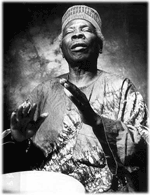Baba's Beginners' Exercises
Tip for newbies: Take advantage of classes
and workshops when they come through your area. There's a lot to
be learned..
 I
was fortunate to have attended one of Baba Olatunji's 3 day workshops
in 1995, and got a series of rhythms from him that are very useful
when working with newbies, very easy to grasp, yet with a nice handle
on what hand drumming is all about; a
doorway in, if you will. The rhythms all work
with each other. I
was fortunate to have attended one of Baba Olatunji's 3 day workshops
in 1995, and got a series of rhythms from him that are very useful
when working with newbies, very easy to grasp, yet with a nice handle
on what hand drumming is all about; a
doorway in, if you will. The rhythms all work
with each other.
Note to facilitators: When you are
working with brand newbies with hand drums, don't put the slap on
them too soon; the 1st three of these lines, mixed around, can be
fun for an entire first session! Let them get used to tones and
bass notes before introducing the slap. When you DO introduce the
slap, try to make sure the students' drums are tuned up well enough
for them to easily achieve it.
These are for ashiko, djembe, and any other hand drums which use
bass, slap and tone as the three main sounds..
Baba's beginner's rhythms are in a '12' feel, four big beats with
the underlying triplets rolling along..
1 2 3 4
5 6 1 2 3 4 5 6
1 . . 2 . . 3 . . 4 . .
to get a feel for it, say, "boogedy boogedy
boogedy boogedy " over and over :-)
Now listen.
This was played on a little timba, directly into the computer with
a cheap Micro Center Microphone; sorry about the lack of low end
on the "gun"
. |
.1. |
... |
... |
.2. |
... |
... |
.3. |
... |
... |
.4. |
... |
... |
1 |
Gun |
. |
go |
do |
. |
. |
Gun |
. |
go |
do
|
. |
. |
2 |
Gun |
. |
go |
do |
go |
do |
Gun |
. |
. |
. |
. |
. |
3 |
Gun |
. |
go |
do |
go |
do |
Gun |
. |
go |
do |
. |
. |
4 |
Gun |
. |
go |
do |
go |
do |
Gun |
. |
pa |
. |
. |
. |
5 |
Gun |
. |
go |
do |
go |
do |
Gun |
. |
pa |
ta |
. |
. |
6 |
Gun |
. |
go |
do |
go |
do |
Gun |
pa |
go |
pa |
go |
. |
7 |
Gun |
. |
pa |
Gun |
. |
pa |
Gun |
. |
pa |
go |
do |
. |
8 |
Gun |
. |
pa |
ta |
pa |
ta |
Gun |
. |
pa |
go |
do |
. |
9 |
go |
do |
. |
go |
do |
. |
go |
do |
. |
go |
do |
. |
. |
1 |
. |
. |
2 |
. |
. |
3 |
. |
. |
4 |
. |
. |
Here they are
in cut and pasteable form, with a little different ascii notation.
in this case,
b = (bass, or
Gun/Dun), o= (tone or go/do), and s=(slap or pa/ta), make sure it
is viewed in courier or another evenly spaced font, or it won't
line up..
To hear the rhythm,
click on the rhythm number.
1..2..3..4..
one
b.tt..b.tt.. (reads: Gun go do)
two
b.ttttb..... (Gun go do go do Gun)
three
b.ttttb.tt.. (Gun go do go do Gun go do)
four
b.ttttb.s... (Gun go do go do Gun pa....)etc
five
b.ttttb.ss..
six
b.ttttbstst.
seven
b.sb.sb.soo.
eight
b.ssssb.stt.
nine
bssbssb.stt.
ten
tt.tt.tt.tt.
================================
Sixteen beat versions
- This is more the way Baba most often played the last four rhythms
during the workshop I attended. I believe I heard him play them
both ways..
1...2...3...4...
seven [16 beat
version]
b.s.b.s.b.s.tt..
eight
b.ss.ss.b.s.tt..
nine
b.ssb.ssb.s.tt..
ten
tt..tt..tt..tt..
|